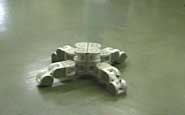The M-TRAN II robot, developed by the Japanese Distributed Systems Design Research Group, is made up of a dozen of modules. Each contains two blocks linked to each other. Each block can rotate 180 degrees around the link that connects it to its mate, and each module contains a magnet that can be switched on and off, enabling it to connect to other modules in the system.

![exp4legsRot[1].jpg](http://www.we-make-money-not-art.com/yyy/exp4legsRot%5B1%5D.jpg)
The modules can rearrange themselves into countless different shapes and create different patterns of movement. M-TRAN can configure itself to march on four legs, shape-shift into a long string of modules that slithers across the floor like a snake, or it can pull itself into a wheel and roll or creep along the ground with its legs splayed out like a spider’s. The robot can even evolve a new walking strategy if it looses one module.
The possibilities are so immense that many of M-TRAN’s patterns of motion aren’t designed directly by human programmers. Genetic algorithms allow the robot to discover new ways of moving on its own. The M-TRAN computer cycles through possible patterns of motion, selecting the most promising ones, sampling their effectiveness, making further selections till the software evolves a new pattern that the robot can adopt.
Future uses for M-TRAN’s descendants include space rovers or deep-sea probes, as well as explorers in unknown or complicated environments, looking for people under debris or fixing leaky valves in polluted areas, such as nuclear plants.
Video.
Via CLippings < Discover.
Related: ATRON, the multi-molecular shape-shifting robot, other shape-shifting robots.
